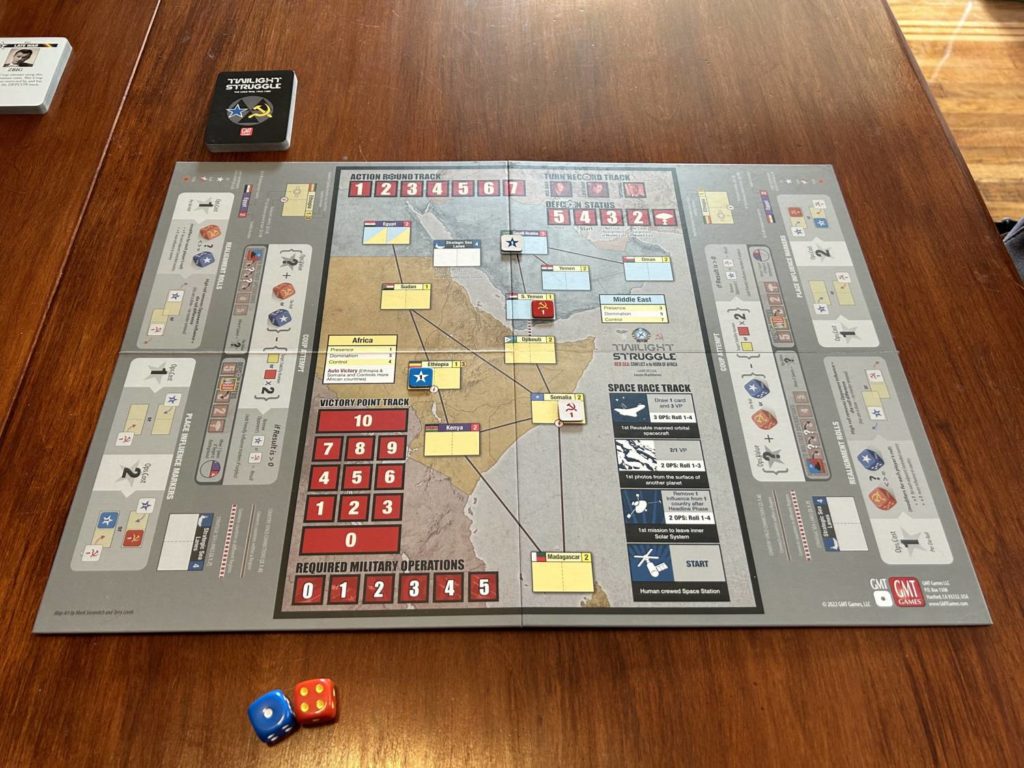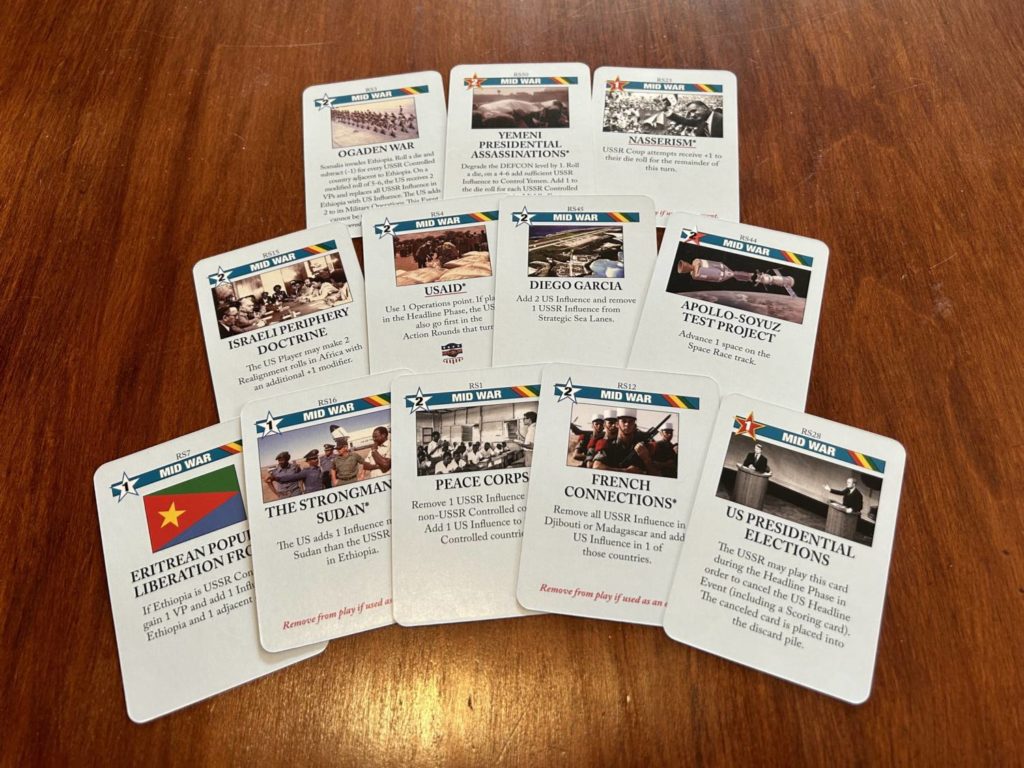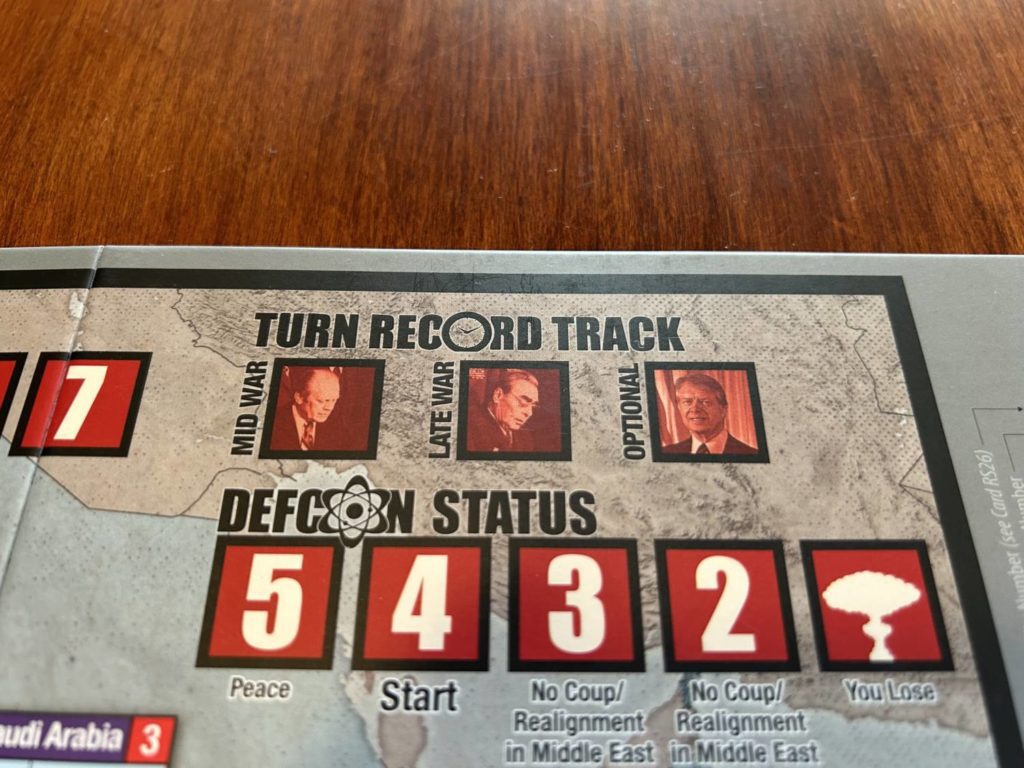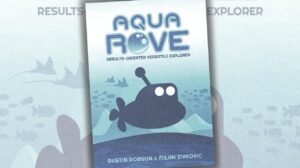Disclosure: Meeple Mountain received a free copy of this product in exchange for an honest, unbiased review. This review is not intended to be an endorsement.
I have long been intimidated by Twilight Struggle, GMT’s deservedly if bizarrely successful two-player game based on the Cold War. It is famously inscrutable and famously long. Playing well, as either the United States or the USSR, requires—requires—knowing the many cards in the deck, and the stages during which they might come out. The rules aren’t that complicated, but remembering the difference between a Coup and a Realignment, remembering what happens when you discard a card for the Space Race, remembering how the DEFCON level works…it’s a bit slippery.
“It’s got a lot of rules, it will take three or four hours, and we’ll need to play a few times to know whether or not we really like it” isn’t a winning pitch for most players. My former roommate would certainly have tolerated an effort, because he loves me, but he wouldn’t have been happy. I try not to push my luck on these matters. It’s important to foster an environment where I can say “Hey, uh, do you want to try this crazy thing?” and the other parties trust that I’m taking an informed swing.
In the absence of a corporeal playmate, I downloaded Twilight Struggle‘s Steam app and tried a few games. I never made it past the second round. The strategy was too obtuse. The board was so wide open that I wasn’t sure where to start. It not only felt like I could never gain any ground, I was constantly losing it. Matters were likely not helped by the fact that I was playing as the United States, who starts the game on the back foot before becoming more powerful in the later rounds. Knowing you’ll be more powerful later doesn’t help when you don’t last long enough to experience that later.
Despite my murky-at-best experiences, I still wanted to play a full game of Twilight Struggle. Such is its reputation within The Hobby™ as an Everest waiting to be climbed. This was a matter of pride for me, if we’re being honest. Twilight Struggle feels like it might be smarter than me, and I can’t have that.
There Is Another
I met the announcement of Twilight Struggle: Red Sea – Conflict in the Horn of Africa with immense and manifold joy. A forty-minute rendition of Twilight Struggle, played across a smaller map, with a smaller deck of cards. Hosanna! I knew it would be easier to get this new Struggle to the table, and I hoped that it would serve as a sort of Twilight Struggle: Training Wheels.

The gameplay is identical. Both players work with cards from a single deck. I say “work with” intentionally; you are often making the most of what you can from a horrible and disadvantageous hand. How the cards manage to be disadvantageous to both players simultaneously is a mystery, but that’s part of the beauty.
Much of the game consists of placing influence in countries around the board, vying for control. Players take turns choosing what card to play, each of which depicts either an individual or an event related to power and politics in the region ca. the mid-to-late 1970s. A card can be played for its Event, its Operation Points, or to advance in the Space Race.
Events are simple enough: you do what the card says to do. Place or remove Influence, mostly, though the ways in which you do this can change significantly from card to card, and there’s more nuance to it than that description conveys.
 Operation Points can be used to place Influence, attempt a Coup, or attempt a Realignment. Influence placement when using Points is dependent on preexisting adjacency, and Red Sea’s sparse board means you’ll need to be very careful about paying attention to the places where you do and don’t have access.
Operation Points can be used to place Influence, attempt a Coup, or attempt a Realignment. Influence placement when using Points is dependent on preexisting adjacency, and Red Sea’s sparse board means you’ll need to be very careful about paying attention to the places where you do and don’t have access.
Coups can have a dramatic effect on the board, threatening to change the alignment of a country at a moment’s notice. Swinging a swung, if you will. Zagging a zig. You roll a die, the result of which is augmented by a number of factors, and remove influence according to the results. Roll high enough, and you may place some Influence of your own. The downside? Coups don’t exactly promote regional stability. A successful Coup moves the DEFCON rating one step closer to the outbreak of nuclear war, which would end the game.
Realignments are a less drastic measure, removing Influence without adding any. Both players roll an augmented die, with Influence in the targeted country adjusted to the difference. The upside to a Realignment is the lack of impact on the DEFCON status.
When you use a card for its Operation Points, there’s something else to consider. Every event has one of three classifications: Soviet, American, or Neutral. If the event on a card belongs to your opponent, it is going to trigger when you play it. You get to choose if it happens before or after you use the Operation Points, but it is going to happen. The only pressure valve is the Space Race track. If you discard a card to try and advance up that track, the event doesn’t trigger. You’re limited to using that once per round, though, and keep in mind that there are only two (2) rounds, with an optional third.
The moment I was sure that Red Sea would be the My First Struggle of my dreams was when I noticed that GMT had taken advantage of the smaller map to add a player aide for the Operation Point actions to each side of the board. Remembering the differences between a Coup and a Realignment was very much an early struggle for me, and having both laid out right there, reminding me of the steps, the math, and the possible results, is a massive and immediate improvement. The addition of those sideboards alone makes Red Sea feel about 50% more approachable than its big brother.

Simple and Clean
Twilight Struggle: Red Sea – Conflict in the Horn of Africa is a tense, short exchange. My first game felt like a stumble through the dark. The outcome was an informed accident, but an accident nonetheless. My second game was immediately more intentional. I noticed when the USSR left South Yemen, a crucial access point to the Middle East, vulnerable. I had a general sense of what cards I and my opponent had, and was able to plan accordingly.
The wonderful Votes for Women made me feel more comfortable in approaching Red Sea. Red Sea, in turn, has made me feel more comfortable in approaching Twilight Struggle. While this box is exactly what I hoped it would be, Twilight Struggle for Dummies, that undersells it. Red Sea is not simplified, it is no less tense, and it is a rich, nuanced match in its own right. All that in about a quarter of the time. I have nothing but great things to say about it, and I can’t wait to boot up Steam tonight to give the full game another go. Though I imagine I’ll lose, I’ll feel a lot better about playing to the end.













Add Comment